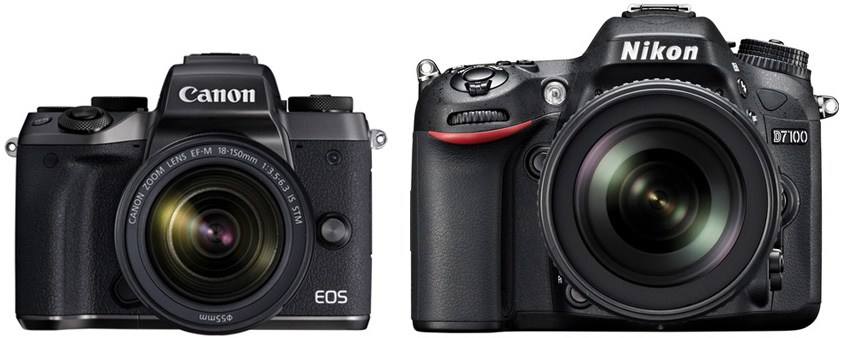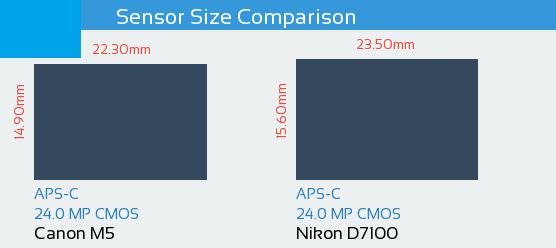Canon M5 vs Nikon D7100
: This article compares Canon’s Semi-Pro Mirrorless camera, the Canon EOS M5, with Nikon’s Semi-Pro DSLR, the Nikon D7100. Both cameras feature a 24.0MP APS-C sensor. To start, here’s a brief overview of the main features of both cameras.
Canon M5 vs Nikon D7100 Specs

Canon M5 vs Nikon D7100
Specifications |
Canon M5 |
Nikon D7100 |
|---|---|---|
| Megapixels | 24.2 | 24.1 |
| Sensor Type | CMOS | CMOS |
| Sensor Format | APS-C | APS-C (DX) |
| Crop Factor | 1.6x | 1.5x |
| AA Filter | Yes | None |
| Image Resolution | 6000 x 4000 | 6000 x 4000 |
| Body Image Stabilization | Yes (Movie only) | No |
| Lens Mount | Canon EF-M | Nikon FX/DX |
| ISO | 100 – 25,600 | 100 – 6,400 |
| Expanded ISO | None | 25,600 |
| AF Points | 49 Hybrid | 51 |
| Cross-type AF Points | Dual Pixel AF | 15 |
| Continuous Mode | 7fps | 6fps |
| LCD | 3.2″ – Articulating | 3.2″ – Fixed |
| LCD Resolution | 1,620,000 dots | 1,228,800 dots |
| Touchscreen | Yes | No |
| Focus Peaking | Yes | No |
| Top LCD Display | No | Yes |
| Viewfinder Type | EVF (2.36M) | Optical |
| Viewfinder Coverage | 100% | 100% |
| Viewfinder Magnification | 0.94x | |
| Video Resolution | 1920×1080 (60/50/30/25/24p | 1920×1080 (60/50/30/25/24p |
| 1280×720 (60/50p) | 1280×720 (60/50p) | |
| Microphone Jack | Yes | Yes |
| Headphone Jack | No | Yes |
| Memory Card Type | SD | SD + SD |
| Dual Card Slots | No | Yes |
| SD UHS Support | UHS-I | UHS-I |
| Fastest Shutter Speed | 1/4000 | 1/8000 |
| Slowest Shutter Speed | 30″ | 30″ |
| Bulb Mode | Yes | Yes |
| JPEG Buffer Size | 27 | 12 |
| RAW Buffer Size | 18 | 5 |
| Time Lapse | Yes | Yes |
| Built-in Flash | Yes | Yes |
| Max Flash Sync Speed | 1/200 | 1/250 |
| Startup Time | 1.2s | 0.3s |
| Built-in Wi-Fi | Yes | No |
| Built-in GPS | No | No |
| Built-in NFC | Yes | No |
| Bluetooth | Yes | No |
| USB Type | USB 2.0 | USB 2.0 |
| Environmentally Sealed | No | Yes |
| Battery Life (CIPA) | 295 shots | 950 shots |
| Battery Included | Yes (LP-E17) | Yes (EN-EL15) |
| Weight | 15.0 oz (427g) | 27.0 oz (765g) |
| Size | 4.6 x 3.5 x 2.4″ | 5.3 x 4.2 x 3.0″ |
| Price | Amazon | Amazon |
| Release Date | 2016 | 2013 |
Nikon D7100 vs Canon M5 Common Features
| Built-in Flash | YesvsYes | Useful in low-light |
| External Flash Shoe | YesvsYes | Better for flash photography |
| Viewfinder | Yes (Electronic)vsYes (Optical) | Better framing and control |
| RAW Support | YesvsYes | Better image quality |
| Face Detection Focus | YesvsYes | very handy for portraits |
| Max Resolution | 24 MPvs24 MP | Bigger prints and more details |
| LCD Screen Size | 3.2″vs3.2″ | Large display |
| Continuous Shooting | 9.0fpsvs6.0fps | Fast shooting speeds |
| Microphone Port | YesvsYes | High-quality audio recording option |
| Timelapse Recording | YesvsYes | creative shooting |
| AE Bracketing | YesvsYes | Useful for tough lighting conditions and HDR |
Canon M5 vs Nikon D7100 Size Comparison
The Canon M5 is unquestionably the smaller of the two cameras. Its body is 20mm narrower, 18mm shorter and 15mm than Nikon D5500. Also, the Canon M5 is significantly lighter (338g ) than the Nikon D7100. A noticeable difference for those who do long photo sessions without a tripod.

Canon M5 vs Nikon D7100
Moreover, both cameras have an APS-C sensor. Hence, the lenses they use are practically the same. So, when factoring in the weight, this is not an issue.
Canon M5 vs Nikon D7100 Sensor Comparison
Both the Canon M5 and Nikon D5500 have APS-C sized 24.0 MP resolution sensors so sensor size and resolution are the same between the two cameras.
However, it is worth mentioning that the Nikon D5500’s sensor lacks anti-alias (Low-Pass) filter. This increases the sharpness and level of detail however it also increases the chance of a ripple effect in certain pictures.

Canon M5 vs Nikon D7100 Sensor Comparison
As both the Nikon D7100 and Canon M5 have the same sensor sizes, they provide a good level of control over the depth of field when used with same focal length and aperture. However, the Nikon D5500 has a 1.1x larger sensor area than Canon M5. Larger sensors give you more control over the depth of field and blurry background compared to the smaller sensor when shot in same focal length and aperture.
Canon M5 Advantages Over Nikon D7100
| Wireless Connection | Built-In vs Optional | Better connectivity |
| Articulating Screen | Yes vs No | Flexible shooting positions |
| Touch Screen | Yes vs No | Easy control of camera functions |
| Max ISO | 25.600 vs 6.400 | 300% higher Max ISO |
| LCD Screen Resolution | 1.620k dots vs 1.229k dots | 31% higher resolution screen |
| Continuous Shooting | 9.0fps vs 6.0fps | 3 fps faster |
| Weight | 427 g vs 765 g | 338 g lighter |
| Price | $929 vs $1,197 | $268 cheaper |
| Selfie Friendly LCD | Yes vs No | Rotate LCD for taking Selfies |
| NFC Connection | Yes vs No | Easy wireless connectivity with compatible devices |
| Bluetooth | Yes vs No | Connect your camera to other devices via Bluetooth |
| Smartphone_remote control | Yes vs No | Remote control your camera with a smartphone |
| Digital video stabilization | Yes vs No | Stabilizes your videos in-camera |
Main reasons to consider buying the M5 instead of the D7100:
- Body Image Stabilization – It has body image stabilization but it only works in video.
- Continuous mode – 7fps vs 6fps. It’s an advantage, but not something you will really notice that often.
- LCD – It’s articulated.
- LCD Resolution – Higher resolution.
- Touchscreen Support
- Focus Peaking – Very useful for seeing if your subject is in focus (both photo and video).
- JPEG Buffer Size – 27 vs 12. Useful for long bursts.
- RAW Buffer Size – 18 vs 5.
- Built-in Wi-Fi
- Built-in NFC
- Bluetooth Support
- Weight – The Canon M5 weighs 338g less.
- Size – The Canon M5 is noticeably smaller.
Video: Canon M5 Hands-on Review
Canon’s latest mirrorless camera promises to be an 80D in a smaller package. With 1080p and a reasonable 24-megapixels, is it another flop or does the Dual Pixel Autofocus save the day? Watch as Kai takes you through the pros and cons.
Nikon D7100 Advantages Over Canon M5
| Number of Focus Points | 51 vs 49 | 2 more focus points |
| Max Shutter Speed | 1/8000s vs 1/4000s | faster shutter speed |
| Battery Life | 950 shots vs 295 shots | 655 more frames with a single charge |
| Headphone Port | Yes vs No | Bbetter video control |
| Environmental Sealing | Yes vs No | Shoot at tough conditions |
| Flash Coverage | 12.0m vs 5.0m | 7m longer range |
| Sensor Pixel Area | 15.28µm2 vs 13.84µm2 | 10% larger pixel area |
| Top LCD | Yes vs No | Helps with viewing and changing settings easily |
| Storage Slot | 2 vs 1 | Extra storage slot |
| Autofocus at f/8 aperture | Center point vs none | Autofocus with teleconverters |
Main points that might sway your decision toward the Nikon D7100 instead of the Canon M5:
- AA Filter – The Nikon D7100 has no AA filter.
- AF Points – 51 vs 49.
- Top LCD Display – When shooting in semi-auto/manual modes, you can quickly preview all of your settings.
- Headphone Jack – Useful for previewing your audio quality straight out the camera.
- Dual Card Slots – More room for extra photos, or simply for backup.
- Faster Max Shutter Speed – 1/8000 vs 1/4000.
- Max Flash Sync Speed – 1/250 vs /200.
- Environmentally Sealed – The Nikon D7100 is suited for shooting outdoors in difficult terrain and bad weather conditions.
- Battery Life – 950 shots vs 295 shots.
Video: Nikon D7100 First Impression Hands-on
You Might Also Like
- Canon M5 vs Nikon D3400: A Complete Comparison
- Canon M5 vs Nikon D3300: A Complete Comparison
- Canon M5 vs Nikon D5600: A Complete Comparison
- Canon M5 vs Nikon D7200: A Complete Comparison
- Canon M5 vs Canon M6: A Complete Comparison
- Canon M5 vs Nikon D5500: A Complete Comparison
- Canon M5 vs Fujifilm X-T20: A Detailed Comparison
- Canon M5 vs Sony A6500: A Detailed Comparison
- Canon M5 vs Fujifilm X-Pro2: A Detailed Comparison
- Canon M5 vs Fujifilm X-T2: A Detailed Comparison
- Canon M5 vs Pentax KP: A Detailed Comparison
- Canon M5 vs Olympus E-M10 II: A Detailed Comparison
- Canon M5 vs Olympus E-M5 II: A Complete Comparison
- Canon M5 vs Pentax 3-K II: A Detailed Comparison
- Nikon D7200 vs Sony A6300: A Complete Comparison
- Nikon D750 vs Panasonic GH5: A Complete Comparison